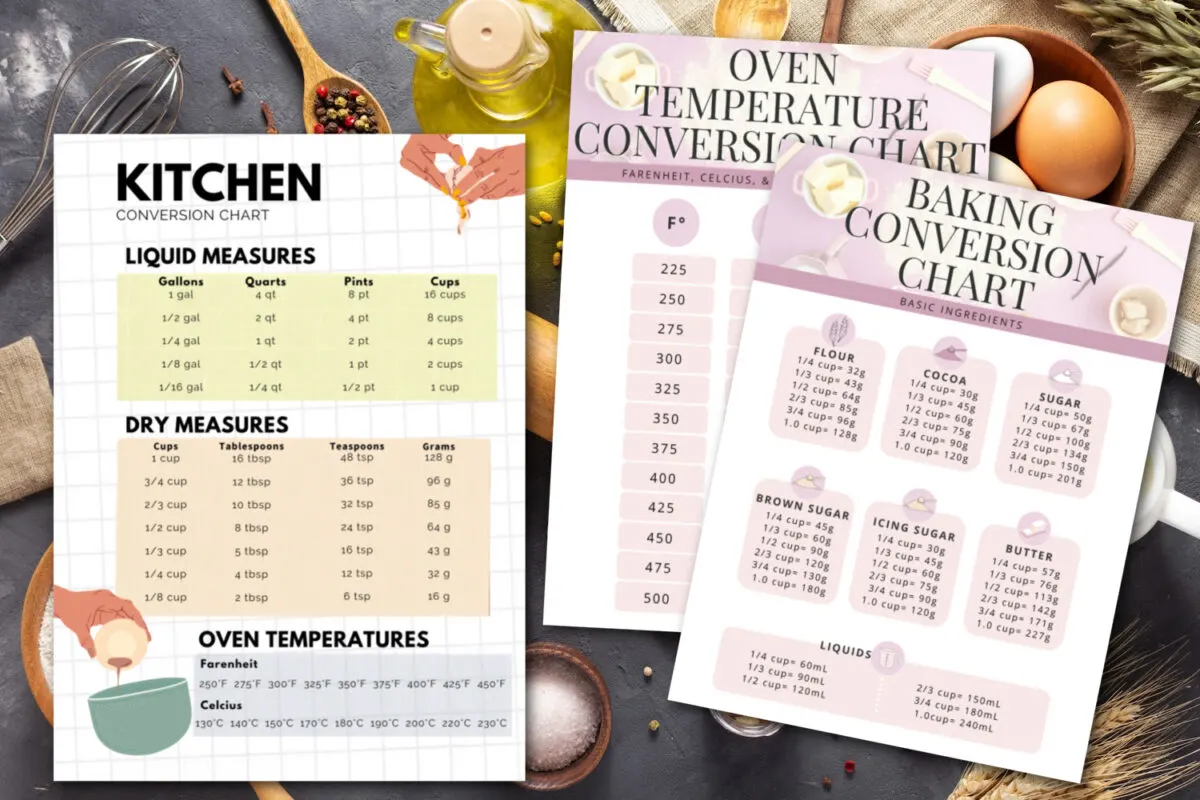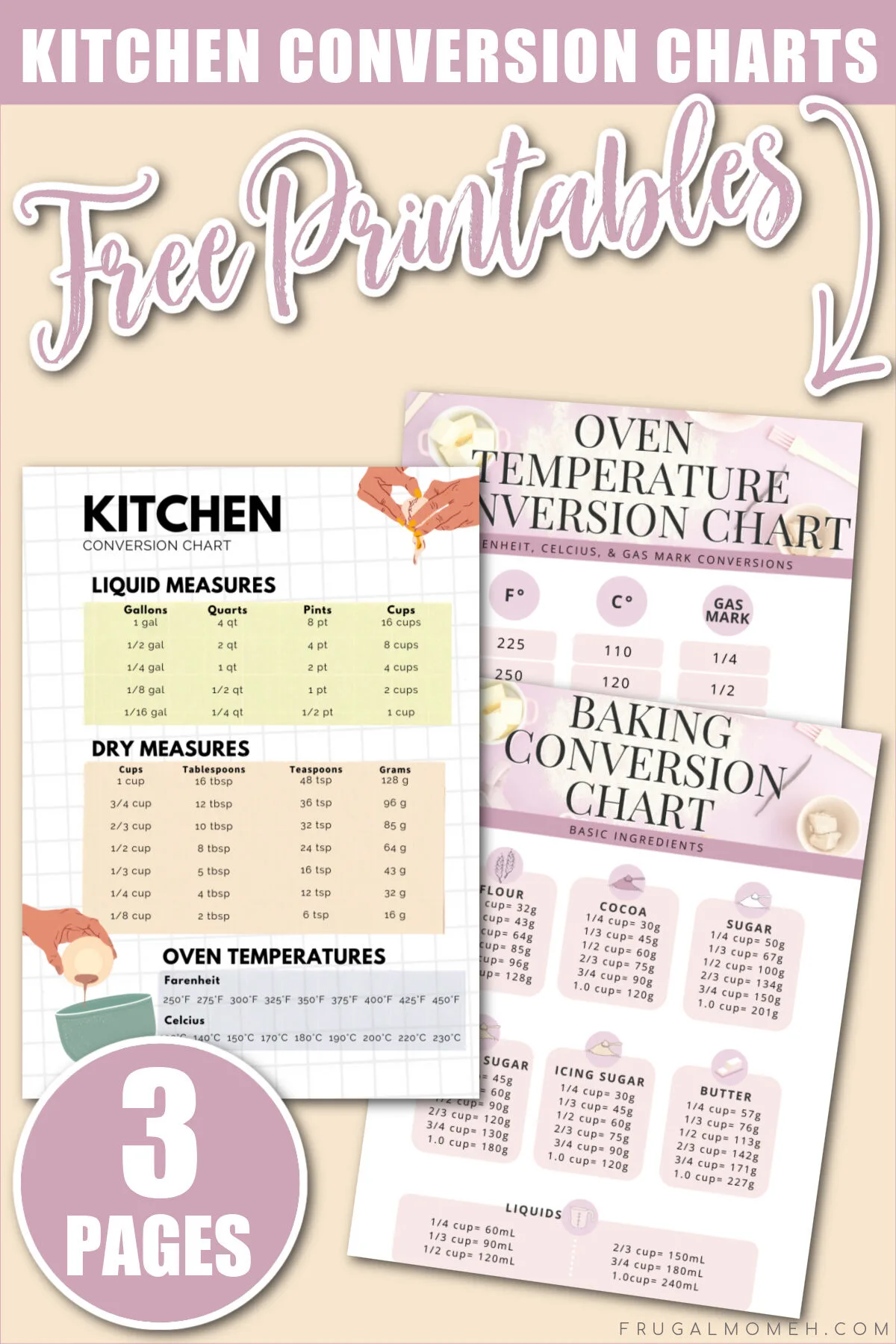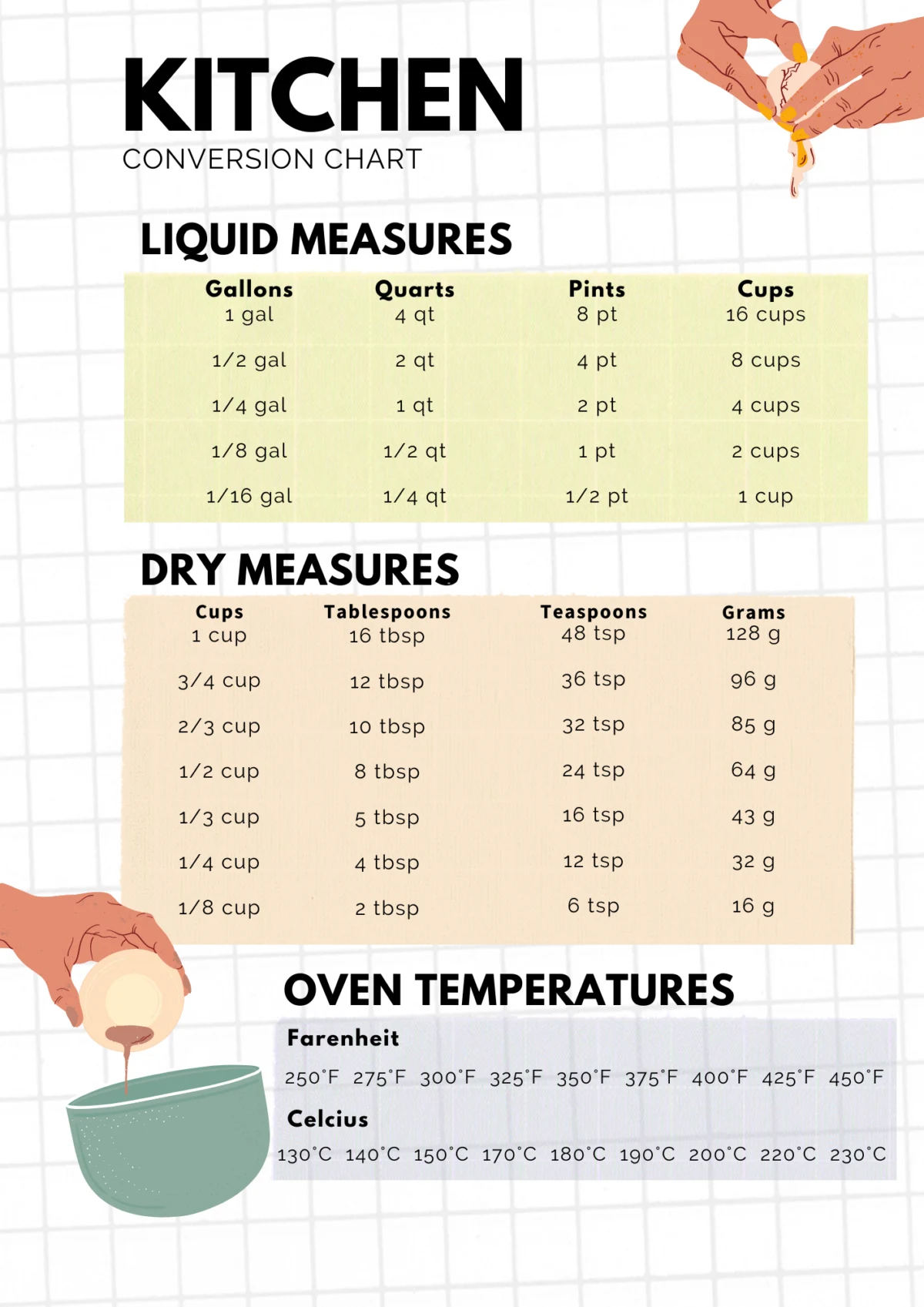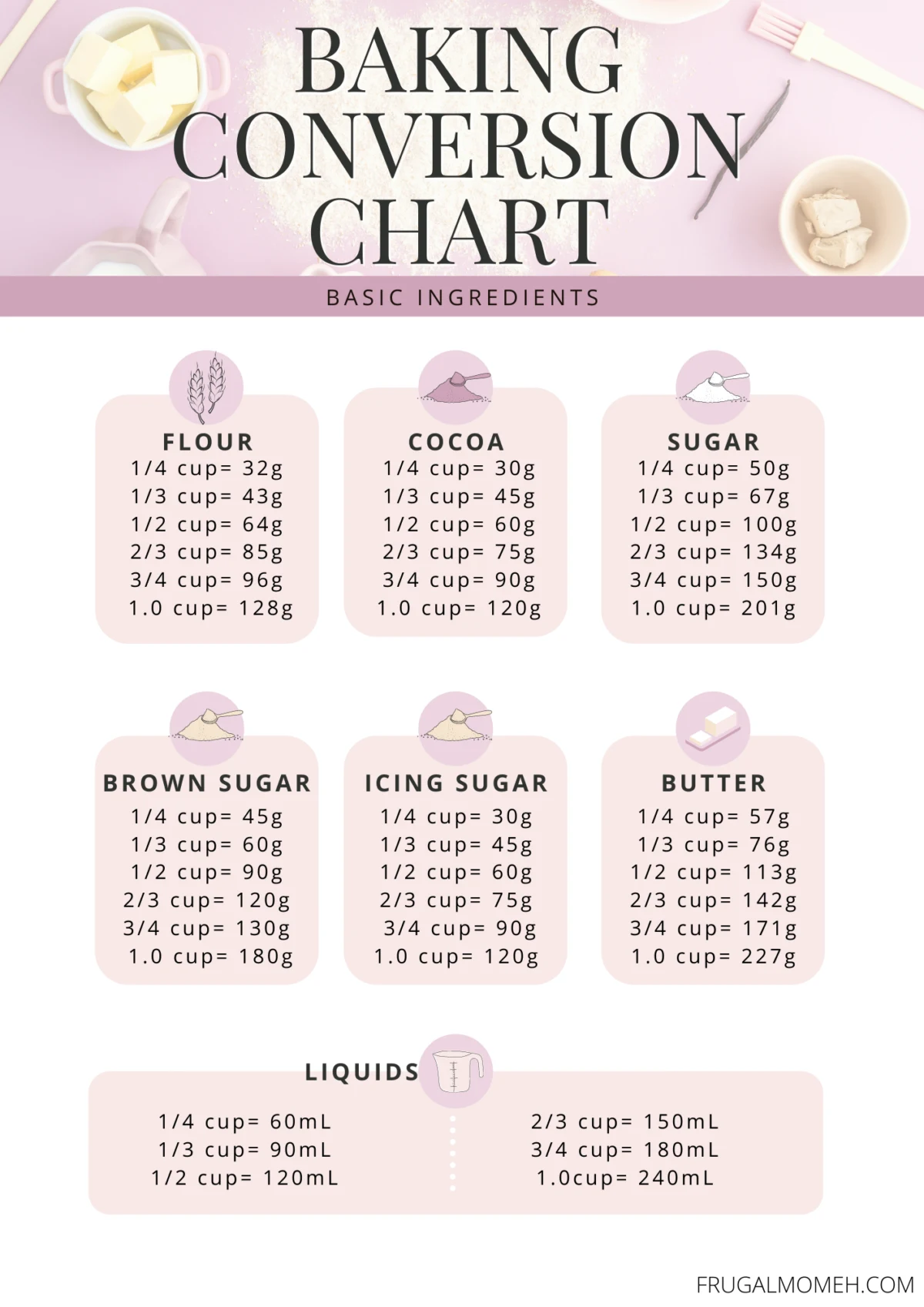This free printable kitchen conversion chart is perfect for any home cook! It includes measurements for volume, weight, and temperature.

Cooking at home can be a fun and rewarding experience, but it can also be a little bit daunting if you’re not familiar with the kitchen lingo.
Do you know how many teaspoons are in a tablespoon? How about how many cups are in a gallon? If not, don’t worry – we’ve got you covered with out kitchen conversion chart!
Today we’re excited to share our free printable kitchen conversion chart with you. This handy guide will tell you everything you need to know about converting measurements from one unit to another.
Whether you’re making a recipe that calls for cups and tablespoons, or millilitres and grams, this kitchen conversion chart will make it easy for you to get precise measurements every time.
You’ll want to make sure you have a copy of this kitchen conversion chart on hand. It’s going to come in handy when you need a quick reference! Laminate and store the kitchen conversions chart somewhere easy to reach when you need it.
We recommend taping the free printables inside of your kitchen cabinet, on the side of the fridge, or storing it in your kitchen binder for easy reference.

Measuring Out Common Baking Ingredients
Basic Kitchen Measuring Tools
There are a few tools that every home cook in Canada and the USA should have in their kitchen. Here is a list of the most essential ones:
Measuring Spoons – Most sets of measuring spoons include 1/4 teaspoon, 1/2 teaspoon, 1 teaspoon, and 1 tablespoon. Some also include 1/8 teaspoon, and 1/2 Tablespoon.
Dry Measuring Cups – These cups come in sets of 1/4 cup, 1/3 cup, 1/2 cup, and 1 cup.
Liquid Measuring Cups – Also called “measuring jugs” or “beakers” these devices usually have a spout for pouring, and most have measurements on the side in cups, ounces (oz), quarts, and milliliters (mL).
Kitchen Scale – A scale is handy for precisely measuring ingredients for baking which is when exact measurements are important. Measuring in grams is more common outside of North America.
Units of Measurement Abbreviations
‘When a recipe calls for “3 Tbsp sugar” it can be confusing for those learning their way around the kitchen. I’ve been working to stop using abbreviations in my recipes just for this reason. Here is a list of the most common abbreviations for common kitchen measurements used in recipes from Canada and the USA.
Volume Measurements
- tsp – Teaspoon
- Tbsp – Tablespoon (typically written with uppercase T to differentiate from tsp)
- C – Cup
- PT – Pint
- Qt – Quart
- gal – Gallon
- mL – Millilitres
- L – Litres
- Fl oz – Fluid Ounce
Weight Measurements
- g – Grams
- kg – kilogram
- lb – Pound
- mg – milligram
- oz – ounce
Cooking and Baking Conversions
Difference Between Dry and Liquid Measurements
Did you know there is a difference between measuring dry ingredients and liquid ingredients?
Dry Ingredients – When measuring dry ingredients like flour, sugar, or spices you should use the “scoop and sweep” method. This means using a spoon to scoop the ingredient into the measuring cup and then using a knife to level off the top.
Liquid Ingredients – When measuring liquid ingredients like milk, water, or oil you should use the “meniscus” method. This means bending down to eye level with the measuring cup and reading the measurement at the point where the liquid curves in at the top.
Weight vs Volume Ounces
Fluid ounces are used to measure liquids, whereas weight ounces are utilized to measure dry goods.
On packaged goods, weight ounces are typically listed as “NET WT OZ”, and liquid ounces are listed as “NET OZ FL”.
Most American recipes, using standard/imperial system, will list dry ingredients by cups or spoons rather than by ounces. The exception being when listing an entire can or package as an ingredient. Just keep that in mind when reading through a recipe.

Dry Conversions
Let’s begin by going over the basic cooking measurements used in North America for dry ingredient volume measurement.
| 3 teaspoons | 1 tablespoon | 1/16 cup |
| 6 teaspoons | 2 tablespoons | 1/8 cup |
| 12 teaspoons | 4 tablespoons | 1/4 cup |
| 24 teaspoons | 8 tablespoons | 1/2 cup |
| 36 teaspoons | 12 tablespoons | 3/4 cup |
| 48 teaspoons | 16 tablespoons | 1 cup |
Liquid Conversions
When converting liquid volumes from one metric unit of conversion to another, things are pretty basic.
Imperial vs Metric
Americans use the Imperial System for measurement, whereas the rest of the world uses the Metric System. Just to make things a little more confusing, Canadians also typically cook and bake using Imperial measurements which is why my recipes generally do not include metric measurements.
Converting Imperial to Metric is easy when measuring out volume, but it gets complicated when we need to convert weight for dry ingredients.
Metric to Imperial Conversion for Volume
| 1/4 tsp | 1 mL | |
| 1/2 tsp | 2.5 mL | |
| 1 tsp | 5 mL | |
| 1 Tbsp | 15 mL | |
| 2 Tbsp | 1 Fluid Ounce | 30 mL |
| 1/4 Cup | 2 Fluid Ounces | 60 mL |
| 1/3 Cup | 2 1/2 Fluid Ounces | 75 mL |
| 1/2 Cup | 4 Fluid Ounces | 120 mL |
| 2/3 Cup | 5 Fluid Ounces | 150 mL |
| 3/4 Cup | 6 Fluid Ounces | 180 mL |
| 1 Cup | 8 Fluid Ounces | 240 mL |
| 2 Cups | 16 Fluid Ounces | 500 mL |
| 4 Cups | 32 Fluid Ounces | 1 L |
Metric to Imperial Conversion for Weight
| 1 gram | .035 ounces | |
| 14 grams | .5 ounces | |
| 28 grams | 1 ounce | |
| 56 grams | 2 ounces | |
| 113 grams | 4 ounces | 1/4 lb |
| 227 grams | 8 ounces | 1/2 lb |
| 454 grams | 16 ounces | 1 lb |
| 1 kg | 35 ounces | 2.2 lbs |
Converting from American Cups to Grams
When converting from American cups (not so precise) to grams (very precise), most measurements vary depending on the ingredient you are working with. For example, 1 cup of all-purpose flour is 128 grams, but 1 cup of raisins is 150g.
Because of this I am sharing two different versions of the chart. One includes conversion for common baking ingredients, and one that includes just the basic conversion without being overly precise down to the specific ingredient. Take your pick.
Common Baking Measurements Converted to Grams
| 1 Cup All-Purpose Flour | 4 1/2 Ounces | 128 grams |
| 1 cup rolled oats | 3 Ounces | 80 grams |
| 1 cup cocoa | 4 Ounces | 120 grams |
| 1 cup granulated sugar | 7.1 Ounces | 201 grams |
| 1 cup packed brown sugar | 6.3 Ounces | 180 grams |
| 1 cup unsifted powdered sugar | 4 Ounces | 120 grams |
Converting Butter Measurements
Butter Conversion Chart from Cups to Ounces to Grams – Imperial to Metric (Rounded up).
You will also find many American recipes call for a stick of butter, which can be a little shocking to anyone outside of the USA as our butter is not typically packaged in sticks.
1 stick of butter = 1/2 cup butter, and a half stick of butter = 1/4 cup butter.
| 1/4 Cup | 2 Ounces | 60 grams |
| 1/3 Cup | 2 1/2 Ounces | 75 grams |
| 1/2 Cup | 4 Ounces | 120 grams |
| 2/3 Cup | 5 Ounces | 150 grams |
| 3/4 Cup | 6 Ounces | 170 grams |
| 1 Cup | 8 Ounces | 225 grams |

Most Common Cooking Conversion Questions
Gallon conversions (Using American Gallons)
A Canadian gallon is 4.5 litres for those who are wondering,
- How many ounces in a gallon? – 128 fluid ounces
- How many litres in a gallon? – 3.785 litres
- How many quarts in a gallon? – 4 quarts
- How many pints in a gallon? – 8 pints
- How many cups in a gallon? – 16 cups
Quart conversions (Using American Quarts)
A Canadian quart is 1.1 litres for those wondering.
- How many pints in a quart? – 2 pints
- How many cups in a quart? – 4 cups
- How many ounces in a quart? – 32 ounces
- How many millilitres in a quart? – 950 ml
Pint conversions
- How many cups in a pint? – 2 cups
- How many ounces in a pint? – 16 ounces
- How many millilitres in a pint? – 480 ml
Cup conversions
- How many tablespoons in a cup? – 16 tbsp
- How many teaspoons in a cup? – 48 teaspoons
- How many fluid ounces in a cup? – 8 fluid ounces
- How many millilitres in a cup? – 240 ml
- How many pints in a cup? – 1/2 pint
- How many quarts in a cup? – 1/4 quart
Tablespoon conversions
- How many teaspoons in a tablespoon? – 3 tsp
- How many ounces in a tablespoon? – 1/2 ounce
- How many millilitres in a tablespoon? – 15 ml
How to Convert Cups to Tablespoons
- How many tablespoons are in 1/16 cup? – 1 tbsp
- How many tablespoons are in 1/8 cup? – 2 tbsp
- How many tablespoons are in 1/4 cup? – 4 tbsp
- How many tablespoons are in 1/3 cup? – 5 1/3 tbsp
- How many tablespoons are in 1/2 cup? – 8 tbsp
- How many tablespoons are in 2/3 cup? – 10 2/3 tbsp
- How many tablespoons are in 3/4 cup? – 12 tbsp
- How many tablespoons are in 1 cup? – 16 tbsp
How to Convert Tablespoons to Teaspoons
- How many teaspoons are in 1 tablespoon? – 3 tsp
- How many teaspoons are in 2 tablespoons? – 6 tsp
- How many teaspoons are in 4 tablespoons? – 12 tsp
- How many teaspoons are in 8 tablespoons? – 24 tsp
- How many teaspoons are in 12 tablespoons? – 36 tsp
- How many teaspoons are in 16 tablespoons? – 48 tsp
How to Convert Tablespoons to Millilitres
- How many millilitres are in 1 teaspoon? – 5 ml
- How many millilitres are in 3 teaspoons? – 15 ml
- How many millilitres are in 6 teaspoons? – 30 ml
- How many millilitres are in 12 teaspoons? – 60 ml
- How many millilitres are in 16 teaspoons? – 80 ml
- How many millilitres are in 24 teaspoons? – 120 ml
- How many millilitres are in 32 teaspoons? – 160 ml
- How many millilitres are in 36 teaspoons? – 180 ml
- How many millilitres are in 48 teaspoons? – 240 ml

Celsius to Fahrenheit Temperature Conversion
I have also included common temperature conversions in case your oven does not show the temperature in both Celsius and Fahrenheit.
So this is another quirk to the Canadian system of measurement. Talking about the weather? We use Celsius for that. Discussing oven temperature? Always in Fahrenheit. Both versions of the conversion chart include an oven temperatures conversion cheat sheet.
- 110 Celsius= 225 Fahrenheit
- 120 Celsius= 250 Fahrenheit
- 140 Celsius= 275 Fahrenheit
- 150 Celsius= 300 Fahrenheit
- 165 Celsius= 325 Fahrenheit
- 180 Celsius= 350 Fahrenheit
- 190 Celsius= 375 Fahrenheit
- 200 Celsius= 400 Fahrenheit
- 220 Celsius= 425 Fahrenheit
- 230 Celsius= 450 Fahrenheit
- 245 Celsius= 475 Fahrenheit
- 260 Celsius= 500 Fahrenheit
DOWNLOAD THE KITCHEN CONVERSION CHARTS HERE
★ HOW TO USE THIS FILE:
………………………………………………………….
- Download the Free Printable Kitchen Conversion Chart or the Free Printable Baking Conversion Chart to your computer to a secure, easily accessible folder.
- Print at home, office (if allowed) or at a professional printing service
★ TERMS OF USE:
………………………………………………………….
You may use this file for your own PERSONAL USE ONLY. File sharing, distribution, and commercial use of this file or of the printed work from this file are prohibited. You are welcome to print as many copies as you like for yourself. The designs can not be used for any commercial purpose or resold. You may NOT use these files for publishing on any platform under any circumstances.

Elizabeth Lampman is a coffee-fuelled Mom of 2 girls and lives in Hamilton, Ontario. She enjoys travelling, developing easy recipes, crafting, taking on diy projects, travelling and saving money!

Kathy Stephan
Saturday 16th of December 2023
I was trying to find a conversion chart that would convert ounces to cups and vice-versa. Trying to make some fudge and cookies and I keep coming up with "ounces" but the ounces do not match to the ounces on a whole package so they need to be measured out. Recipe called for 5 ounces for example.. How many cups would that come to. If recipe called for cups then it is easy to measure but many of my recipes do not do that. [I think they come from Canada]. Liquid measure is easy if you have a measuring glass which will do ounces. I do have small measuring glass and I have to use it for dry and liquid as I am not sure which it is geared for. [it does tsp, tbs, & oz.] I think it is for dry as a liquid measuring cup has a lip to pour. Is there a chart that will convert ounces to cups.
Elizabeth Lampman
Saturday 16th of December 2023
Hi Kathy, Canadians don't actually use ounces, we use grams instead. Ounces are American. Which means I often encounter this exact issue when trying to follow recipes online.
Converting dry ingredients from ounces (or any weight measurement) to cups is difficult, as it differs ingredient to ingredient. Your best bet in this case is to google the ingredient - ie. - "6 oz chocolate chips to cups" and then making sure the answer you are referencing isn't converting fluid ounces to cups, but rather dry ounces. In this case, 6 oz of chocolate chips is 1 cup. However, 6 oz of chopped walnuts is 1 and a half cups.
Hope this helps!
The other solution is to get a kitchen scale, mine has ounces on it as well as grams, and would help you skip converting altogether.
Ruth
Saturday 16th of April 2022
Thank you so much. Love your recipes
Elizabeth Lampman
Saturday 16th of April 2022
You are welcome! Thank you so much for the compliment, have a wonderful weekend!